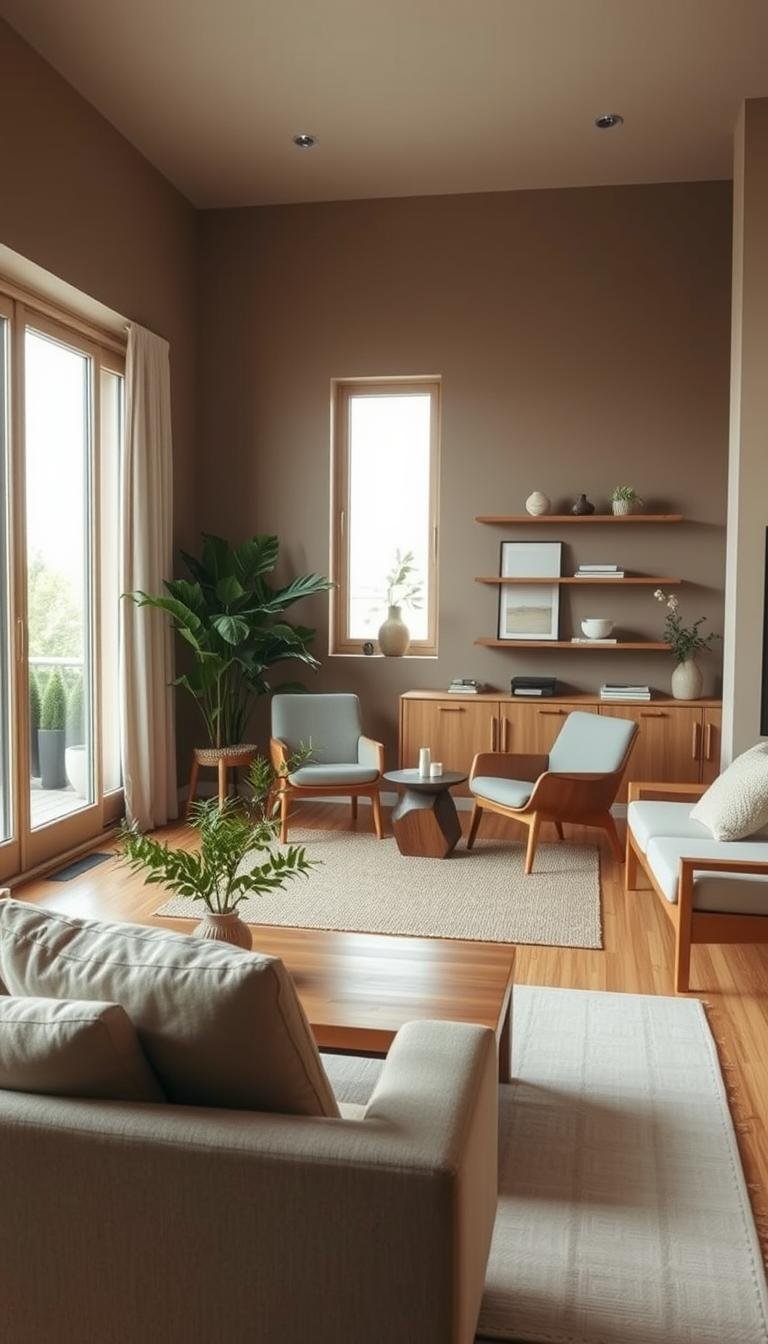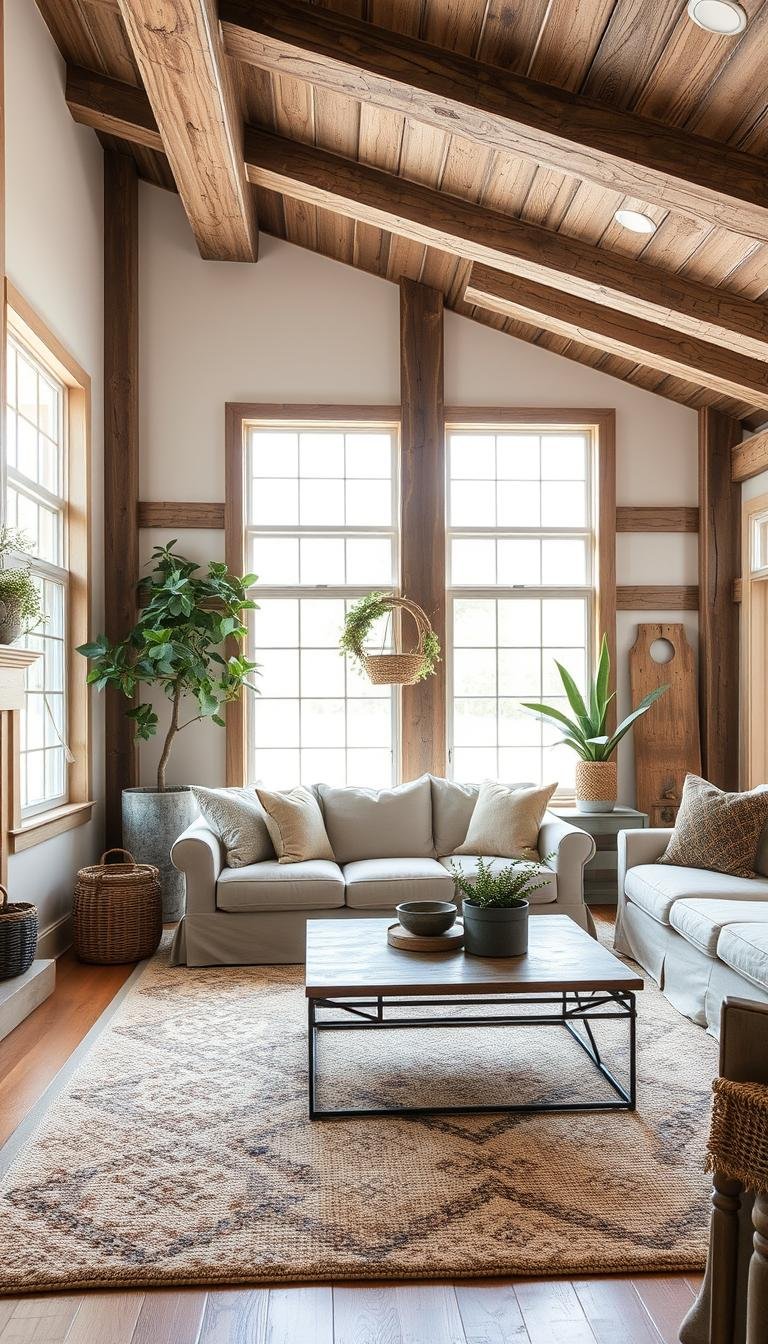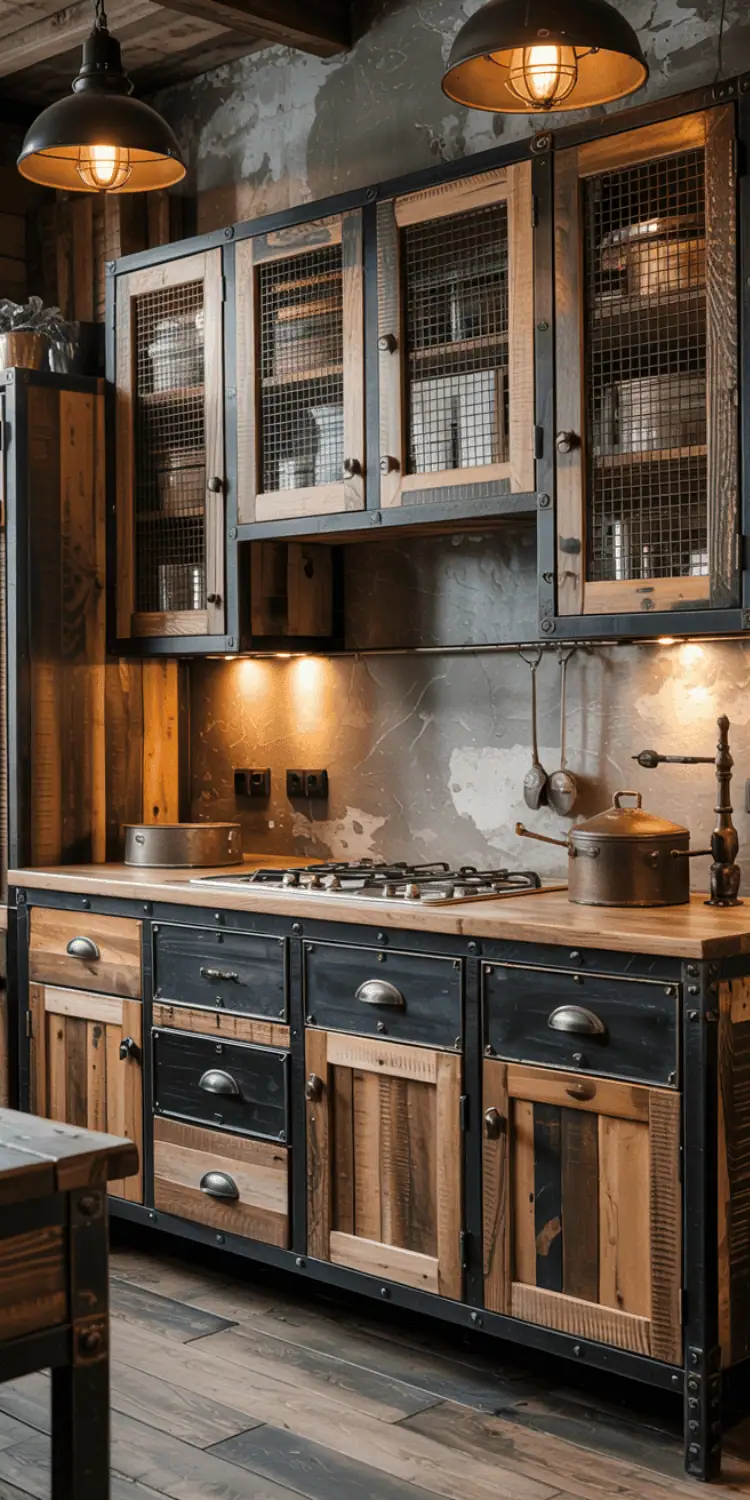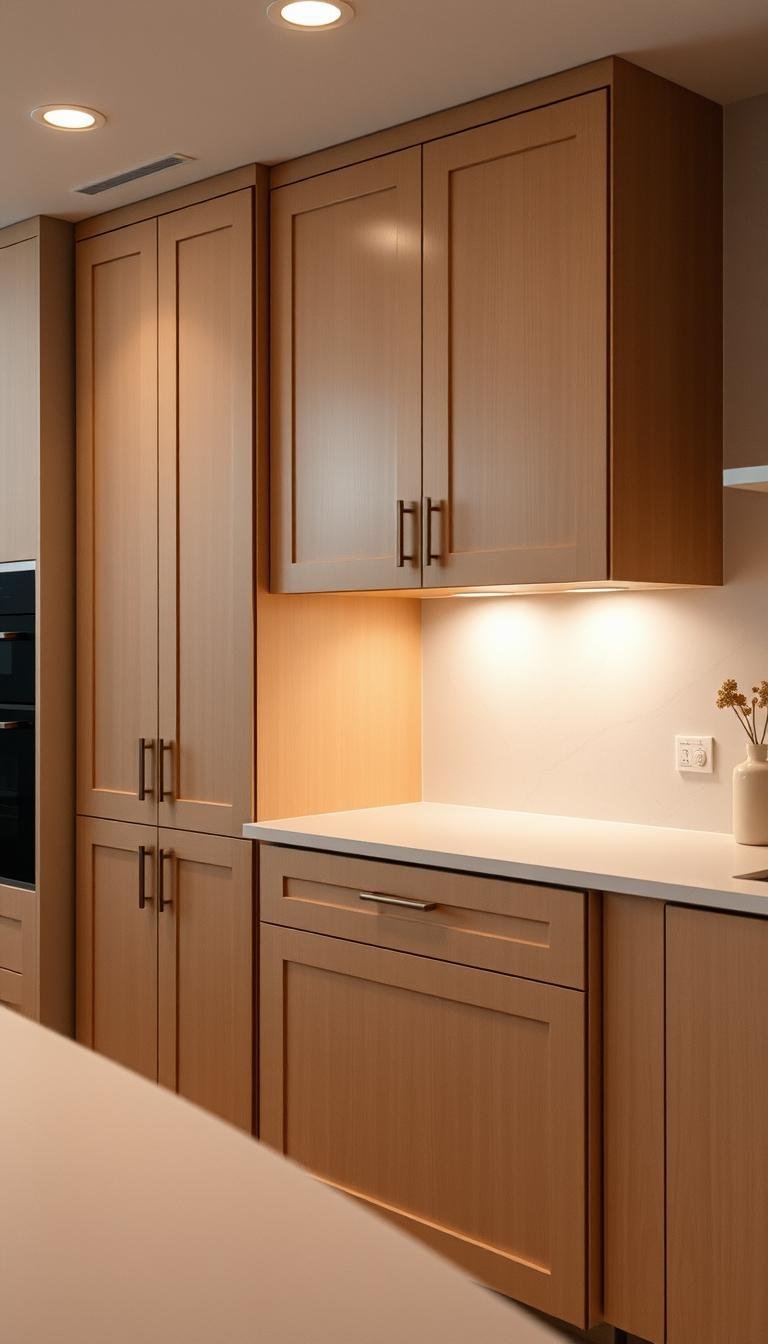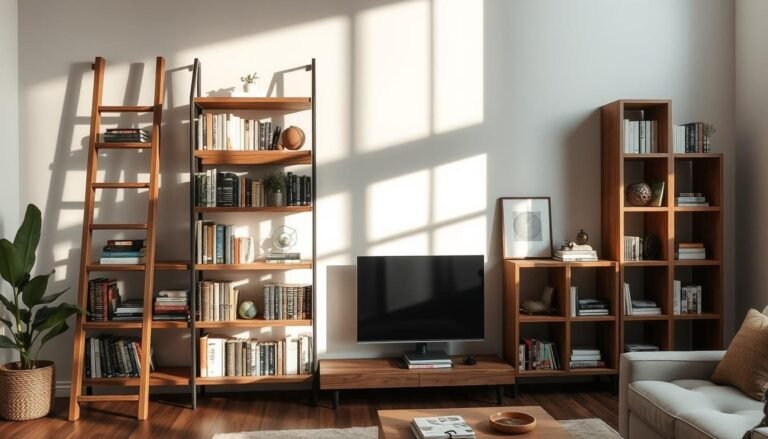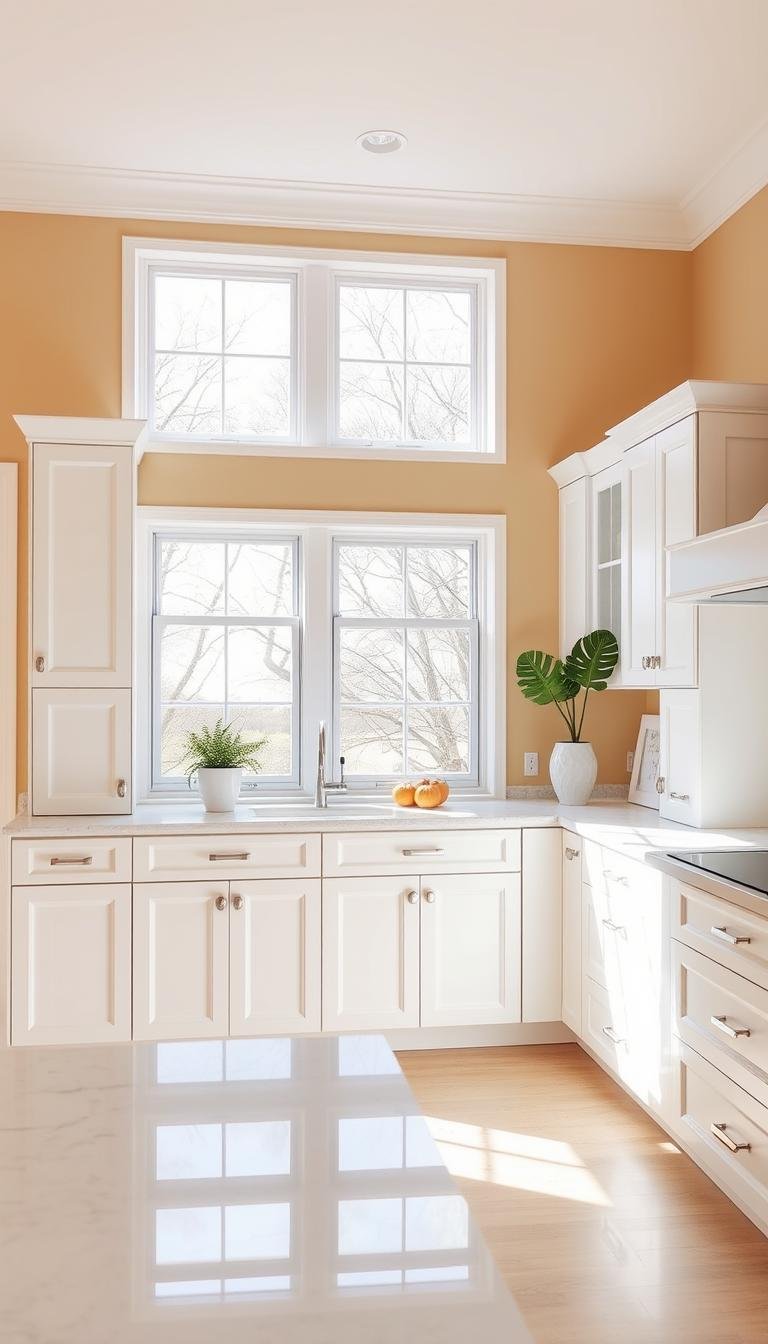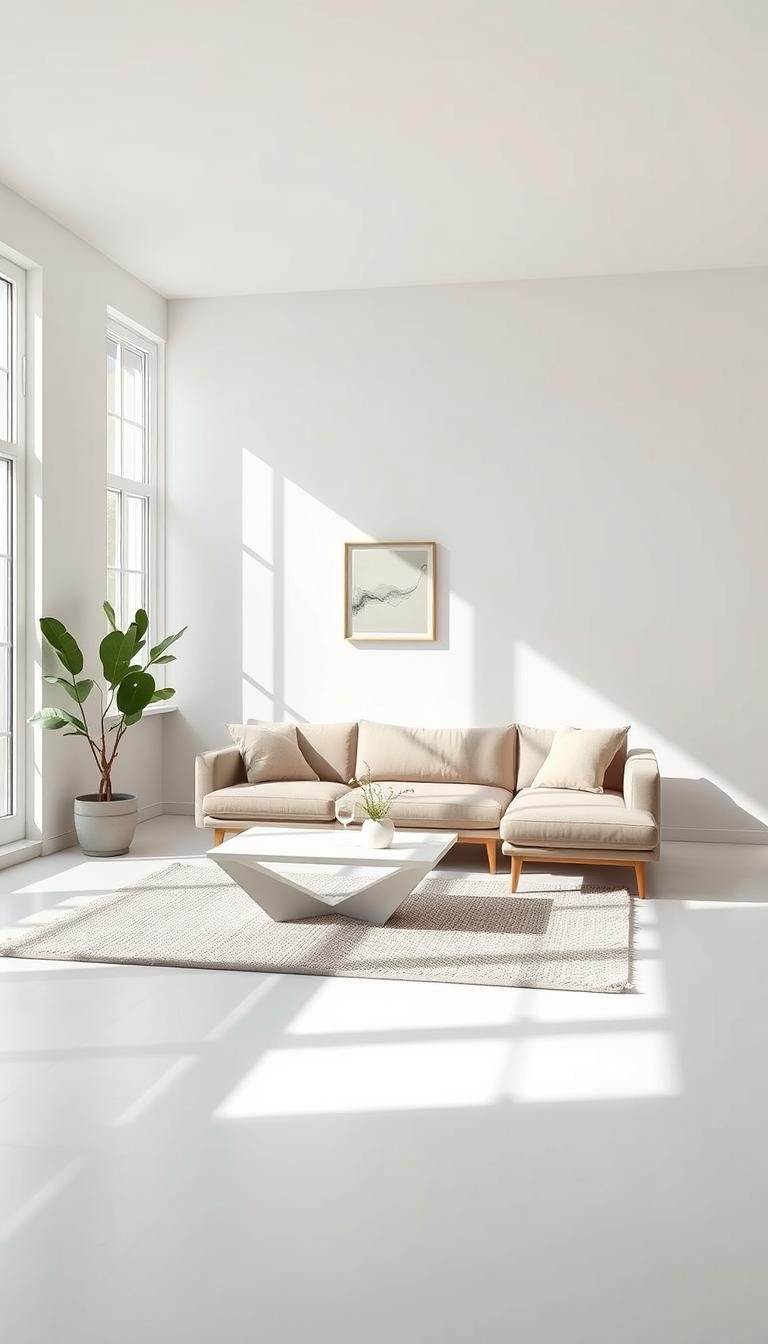This post may contain affiliate links. If you click and buy, we may earn a small commission at no extra cost to you. Learn more.
I’m thrilled to share my love for japandi style with you! This design has changed how I see creating calm spaces. When I first found it, I knew it would inspire you too.
Japandi is a mix of Japanese minimalism and Scandinavian hygge. It makes spaces feel both calm and welcoming. This style uses natural materials, neutral colors, and clean lines for instant peace.

In this guide, I’ll share what I’ve learned about minimalist living room design. You’ll see how to mix function with beauty. It’s all about making choices that improve your well-being. I love how it’s all about quality over quantity and finding happiness in simplicity!
Contents
- 1 1. Understanding the Japandi Aesthetic Philosophy
- 2 2. Master the Japandi Color Palette
- 3 3. Choose Furniture with Clean Lines and Natural Materials
- 4 4. Embrace Natural Textures and Materials
- 5 5. How to Style a Japandi Living Room That Feels Calm and Chic with Lighting
- 6 6. Curate Minimalist Decor and Accessories
- 7 7. Integrate Plants for Natural Serenity
- 8 8. Optimize Storage Solutions for Clutter-Free Living
- 9 9. Layer Textiles for Comfort and Warmth
- 10 Creating Your Perfect Japandi Sanctuary
1. Understanding the Japandi Aesthetic Philosophy
I’m really into how japandi design makes living spaces peaceful. It mixes japanese minimalism and scandinavian design in a way that feels both planned and natural. Once you get these ideas, every choice in design has a special meaning.
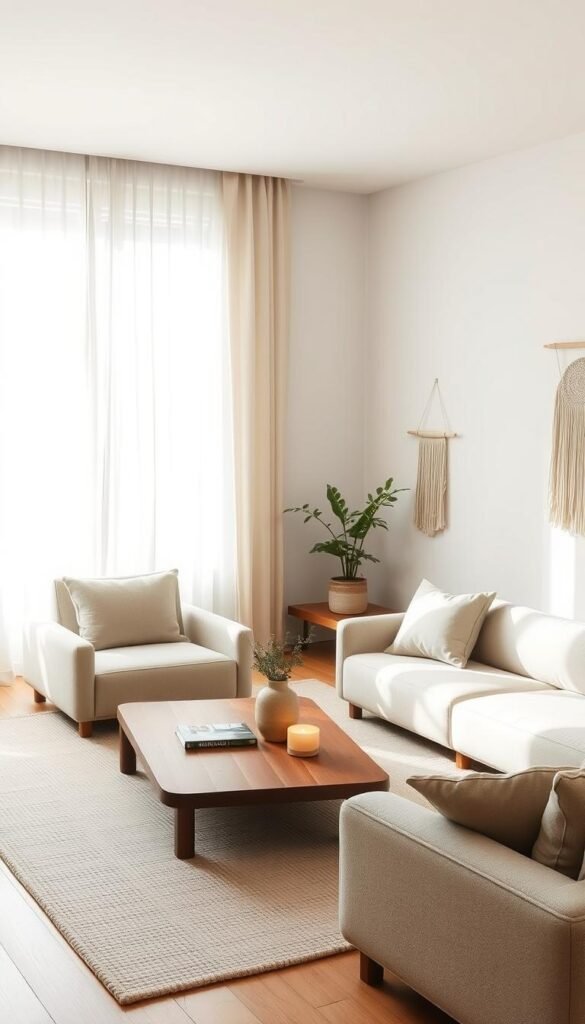
The charm of japandi is in how japanese minimalism and Scandinavian hygge come together. Japanese design adds clarity and purpose. Scandinavian design brings warmth, making you want to relax with a book.
This isn’t about picking one style over the other. It’s about finding a balance. Where clean lines meet cozy textures, and simple design meets comfort.
Core Principles: Wabi-Sabi Meets Functionality
Wabi-sabi teaches us to see beauty in imperfection and aging. This Japanese idea works well with Scandinavian functionality. Here’s why it’s so great:
- Natural materials that age well over time
- Furniture that’s both functional and beautiful
- Textures that add warmth and character
- Choosing quality over quantity
Creating Emotional Balance Through Design
Japandi design creates emotional balance by keeping things simple yet warm. It encourages us to value quality craftsmanship. Your living room becomes a cozy spot after a long day!
Understanding these principles makes every design choice meaningful. It supports your emotional well-being.
2. Master the Japandi Color Palette
I’m excited to share my top tips for a stunning Japandi color scheme in your living room! The neutral color palette is key. It makes this style elegant, calm, and timeless.
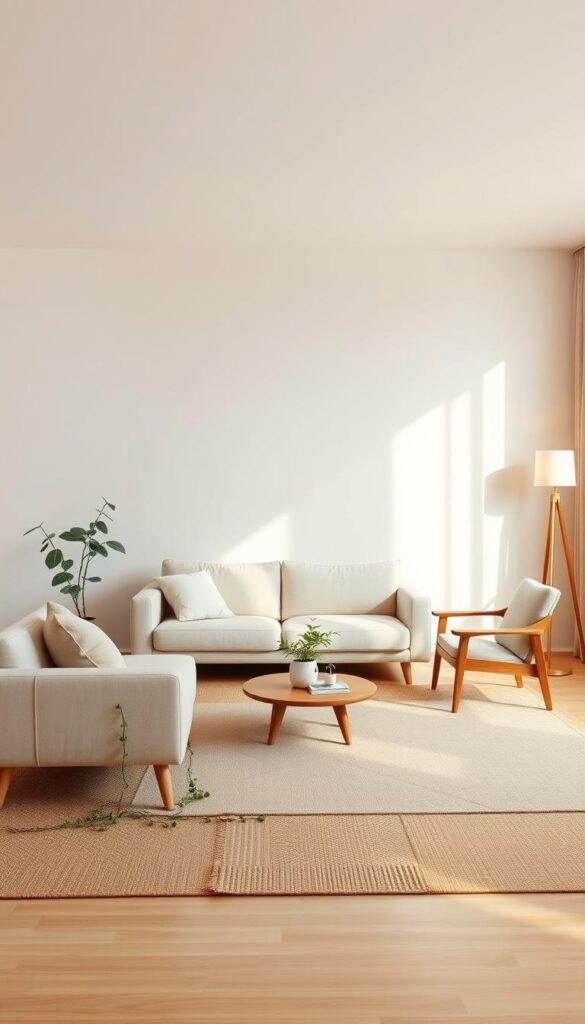
Essential Neutral Tones: Whites, Beiges, and Warm Grays
I begin with creamy whites and soft beiges. These neutrals create a peaceful base. They make your space feel clean and welcoming.
Warm gray tones are my go-to for depth. They add richness without overwhelming your room. These grays change with the light, making your space feel alive.
Incorporating Subtle Earth Tones
Now, the magic unfolds! I add earth tones like mushroom, sage, and terracotta through textiles and accessories. These colors warm your space without making it feel too cozy.
It’s all about using warm gray tones and earth colors wisely. Start with throw pillows, ceramics, or a rug. This way, you can add warmth without overdoing it.
Strategic Use of Black Accents
Now, your Japandi design gets really interesting! I use black in small, but impactful ways. Think sleek picture frames, vases, or furniture legs. These dark touches ground your space and add contrast.
“The beauty of this color scheme is its incredible versatility. You can easily refresh your space seasonally by adjusting the balance between cooler and warmer neutrals.”
Mastering this timeless palette makes your space feel harmonious and intentional. It’s all about balance and beauty.
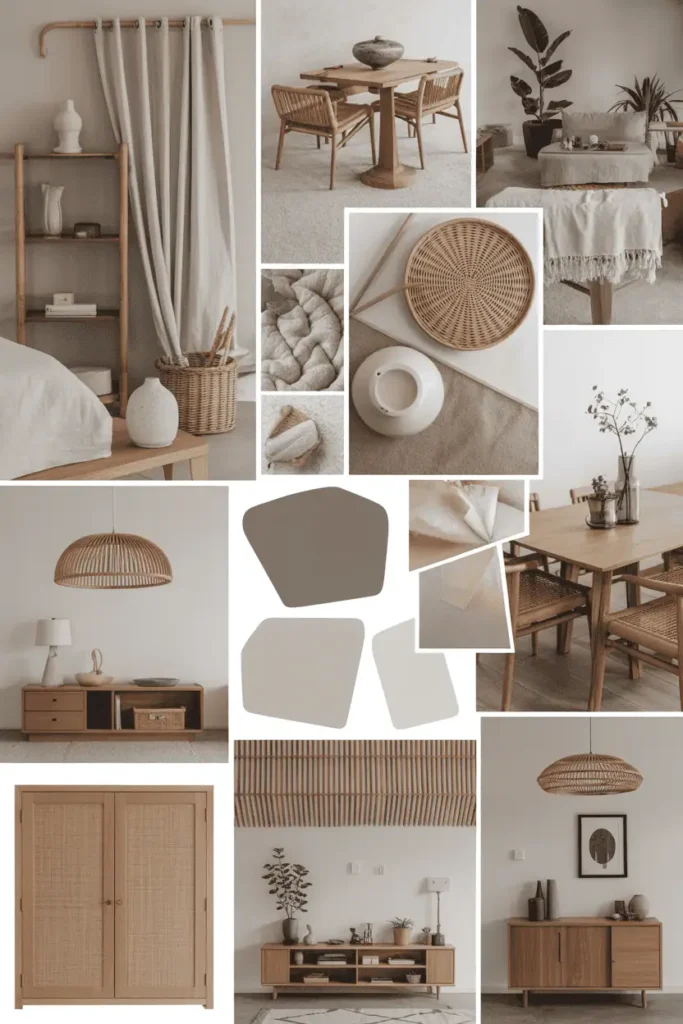
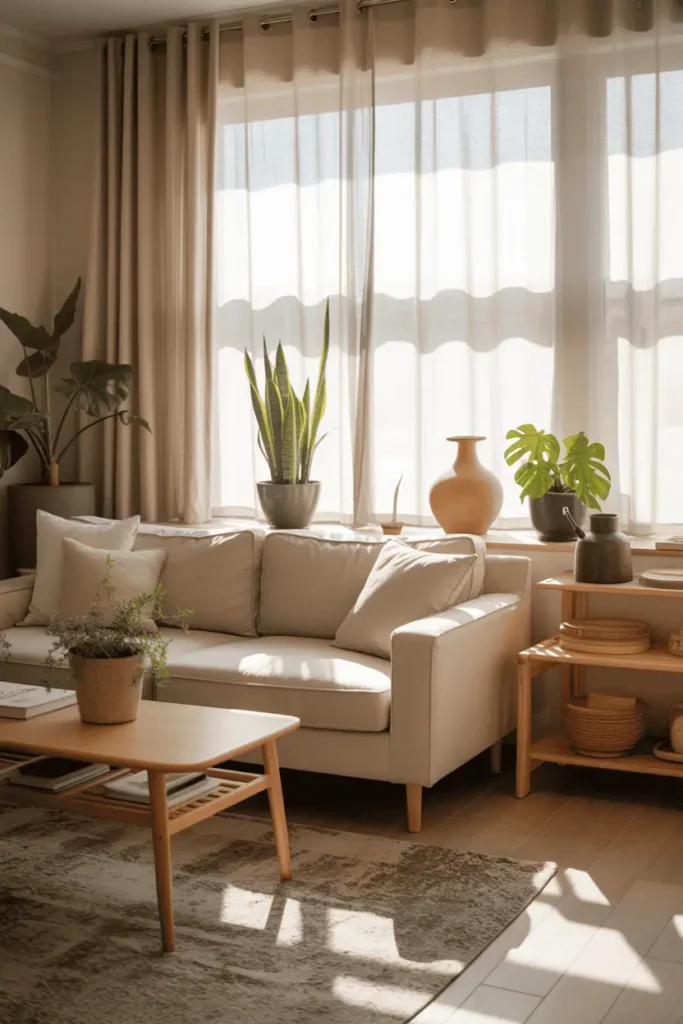
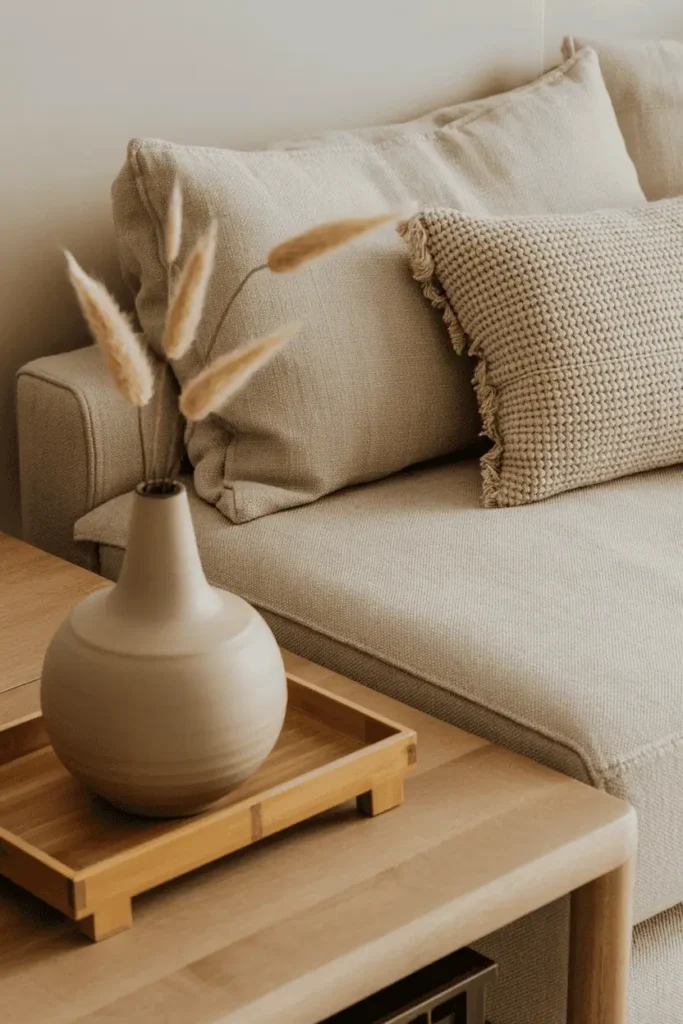
3. Choose Furniture with Clean Lines and Natural Materials
I think clean lines furniture and natural materials make living rooms peaceful. It’s about picking items that look simple and uncluttered. This mix of Japanese minimalism and Scandinavian comfort is key.
Each piece should add to the calm and be useful. This balance is what makes a room feel serene.
Low-Profile Seating Options
Low-profile seating is vital for japandi design. I prefer sleek sofas with no arms and a simple shape. They sit low, making the room feel more connected to the earth.
Floor cushions and meditation chairs are great for adding cozy spots. They’re perfect for reading or meditating. They make the room feel more intimate and calm.
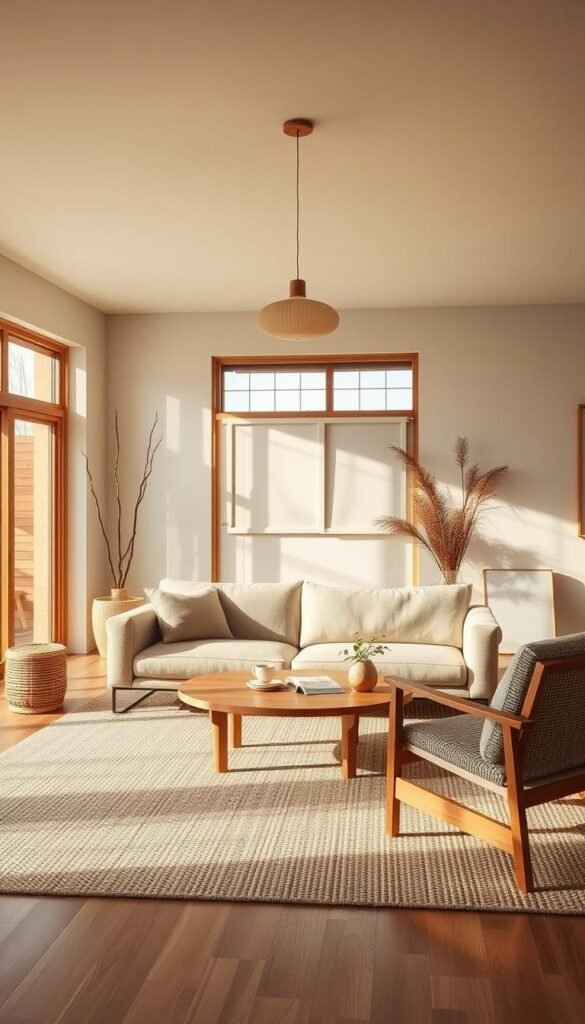
Multi-Functional Coffee Tables and Storage Pieces
Multi-functional furniture is a highlight of japandi design. Coffee tables with hidden storage and ottomans that double as seats are great. They keep things tidy while keeping the room peaceful.
Console tables that do more than one thing are also excellent. Look for ones with simple designs that can hold books and display ceramics. Their beauty comes from being simple and useful.
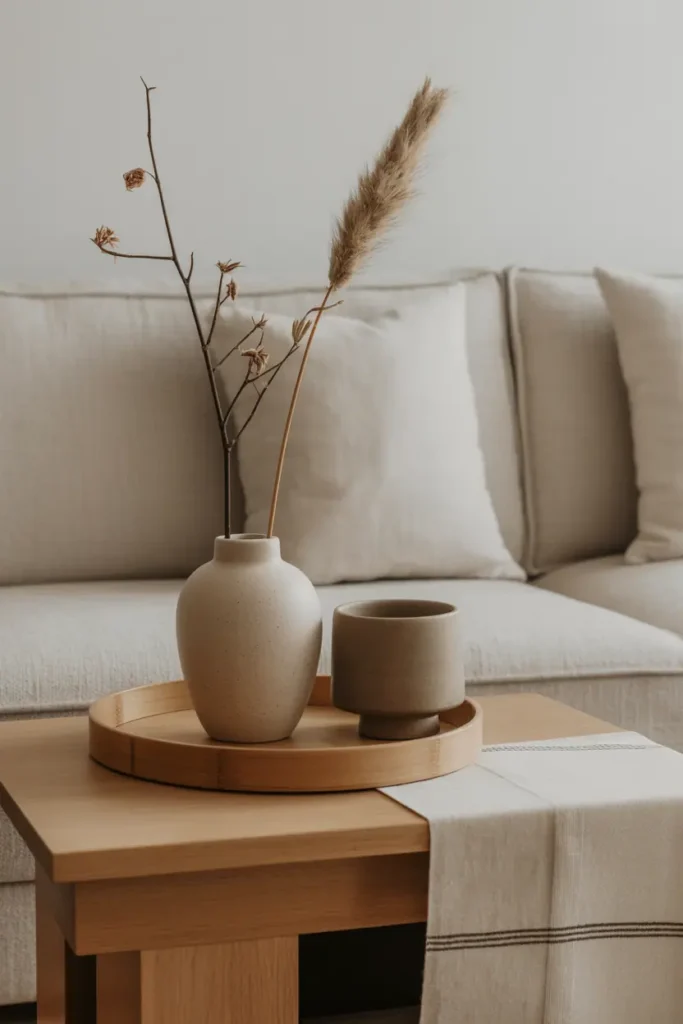
Selecting Wood Finishes: Oak, Ash, and Cedar
Natural wood finishes are essential for true japandi style. Oak adds warmth and lasts long, with beautiful grain patterns. Ash is lighter, making spaces feel brighter.
Cedar brings a nice scent, adding to the room’s feel. I choose furniture that shows off the wood’s natural look. No heavy stains or glossy finishes are needed. The goal is for furniture that feels like it belongs in your space.
4. Embrace Natural Textures and Materials
I’m really into how natural textures can make a Japandi living room pop! It’s all about mixing different organic materials to add depth and interest. This keeps the space calm and clutter-free.
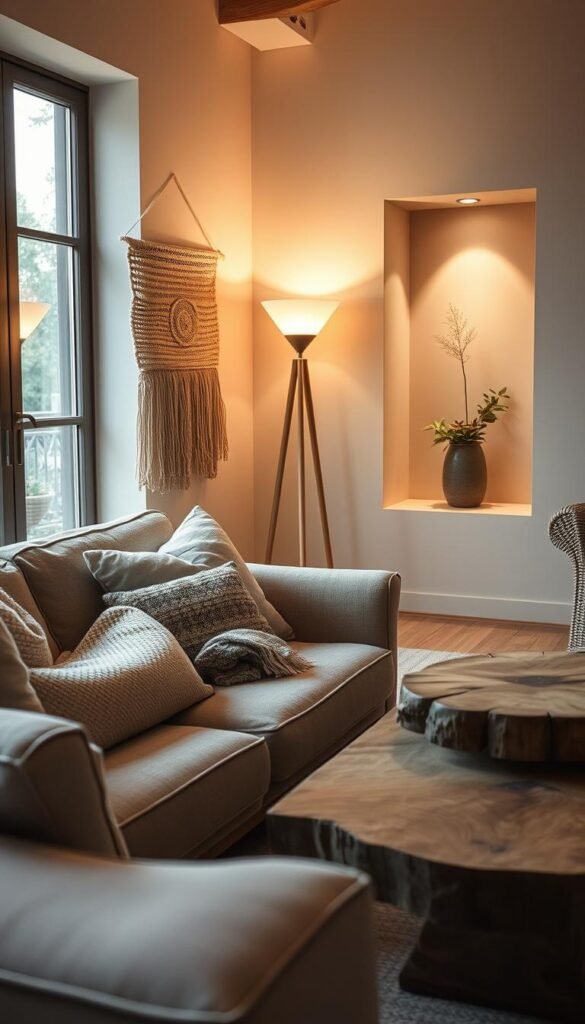
Incorporating Rattan and Bamboo Elements
Rattan and bamboo are my top picks for Japandi decor! They add beautiful, organic shapes that soften the space’s clean lines.
I adore adding a rattan accent chair or a bamboo room divider. They bring warmth and a handmade feel. The natural patterns add texture without cluttering the space.
Stone and Ceramic Accents
Stone and ceramic accents are amazing in Japandi design! I use river rocks, ceramic bowls, and stone coasters for their natural beauty.
These elements connect us to nature and add weight. The beauty of handmade ceramics fits perfectly with Japandi’s wabi-sabi philosophy.
Linen and Cotton Textiles
Linen and cotton textiles are key for comfort and softness! I pick natural, undyed fabrics for their luxury feel.
Think linen throw pillows, cotton curtains, and soft throws. Their imperfections, like linen’s wrinkles and cotton’s softening, add to the space’s charm.
5. How to Style a Japandi Living Room That Feels Calm and Chic with Lighting
Lighting makes any Japandi living room special! The right lights can totally change the feel of your space. It’s all about creating soft, layered light that’s both functional and calming.
Maximizing Natural Light Sources
Natural light is key in any Japandi room. I start by letting in as much sunlight as possible. Use sheer linen curtains that let light through but keep it soft.
Natural light changes the mood of your room all day. Morning light is fresh and energizing. Afternoon light adds warmth and coziness.
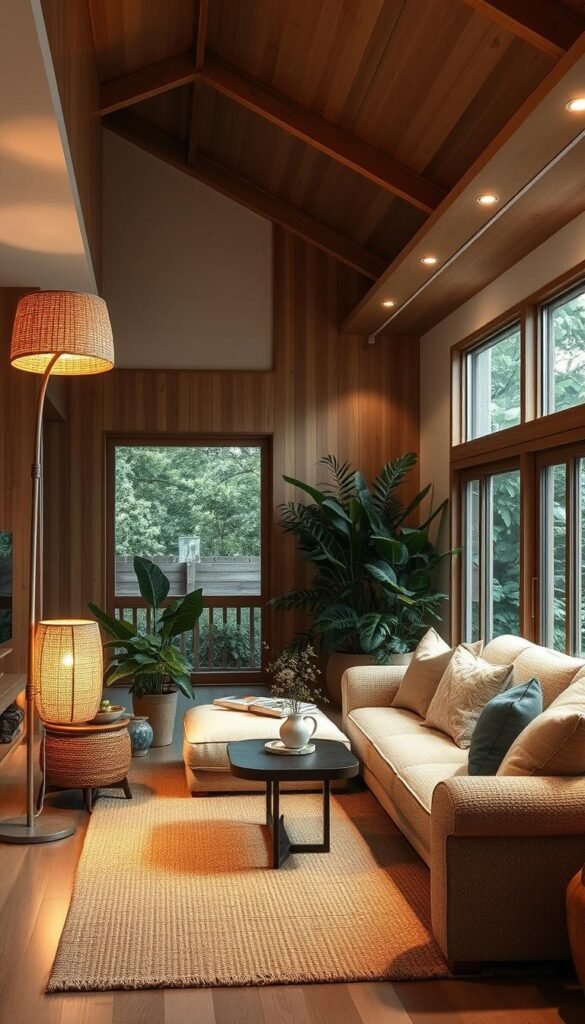
Paper Lanterns and Pendant Lighting
Paper lanterns add a beautiful touch of Japanese tradition and soft light. They can be used as focal points or scattered around for interest.
Pendant lights with simple shapes work great too. Look for ones in natural materials like bamboo or ceramic to match your style.
Creating Warm Ambient Lighting
This is where the magic happens! I use different light sources at various heights. Floor lamps, table lamps, and candles create a cozy vibe.
Avoid harsh overhead lights. Instead, use soft ambient lighting that encourages relaxation. Warm-toned LED bulbs and dimmers help adjust the mood.
6. Curate Minimalist Decor and Accessories
I’m really into how minimalist decor changes a Japandi living room! It’s all about picking a few items that really stand out. Each piece gets to be the star when it has room to shine.
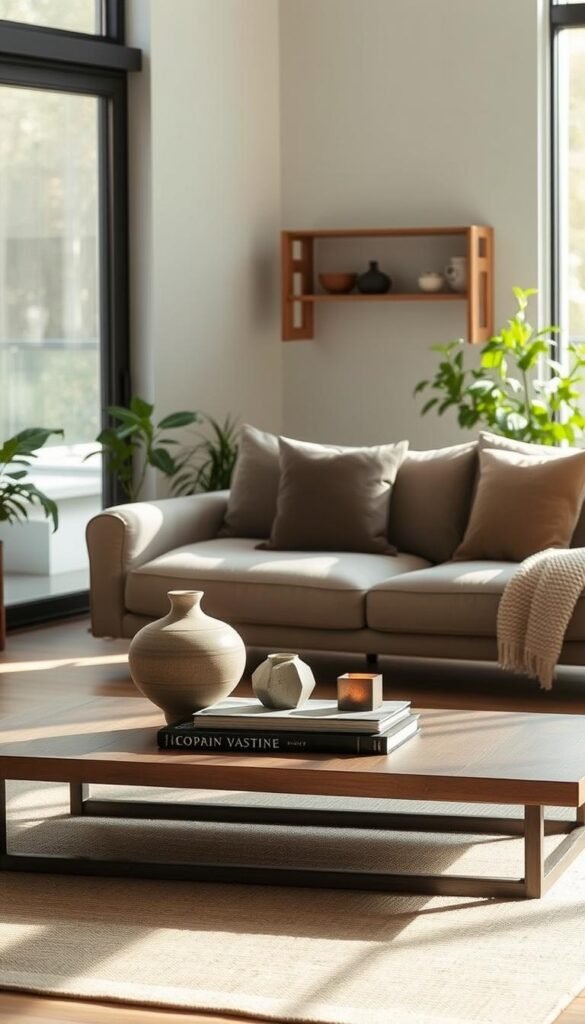
The Art of Selective Styling
With curated accessories, less is more in Japandi spaces. This style makes you think carefully about each item. Each piece must be useful and look good.
Choosing items that tell a story and fit well together is key. I ask myself: Does this piece bring joy, serve a purpose, or enhance the peaceful atmosphere? If not, it’s out.
Handcrafted Pottery and Ceramics
Handmade pottery adds a special touch to any Japandi room! I love items with unique flaws – bowls that aren’t perfectly round, vases with natural colors, and cups that feel right in your hand.
These handcrafted elements follow the wabi-sabi idea of finding beauty in imperfection. Each piece feels unique and adds warmth and character to your space.
Meaningful Art and Wall Hangings
Choose art that touches your heart and keeps the calm vibe! I pick pieces that show natural themes – abstract landscapes, botanical prints, or simple drawings. These items should add to the peaceful feel, not clash with it.
A single, well-chosen piece can be a stunning centerpiece. It should draw the eye without feeling too much. Every accessory should help keep the Japandi design peaceful and special!
7. Integrate Plants for Natural Serenity
The magic of indoor plants in Japandi design is their ability to bring natural serenity. They add life to minimalist spaces while keeping that essential nature connection. This is key to the design philosophy.
Best Plant Varieties for Japandi Spaces
Choosing the right plants is important for the perfect balance. I suggest these low-maintenance varieties that do well in calm, often dimly lit areas:
- Snake plants – have architectural lines that match clean furniture
- Peace lilies – have elegant white blooms and glossy green leaves
- Rubber trees – have a big presence without taking over the space
- Fiddle leaf figs – are sculptural and great for corners
- Bamboo plants – honor the Japanese influence
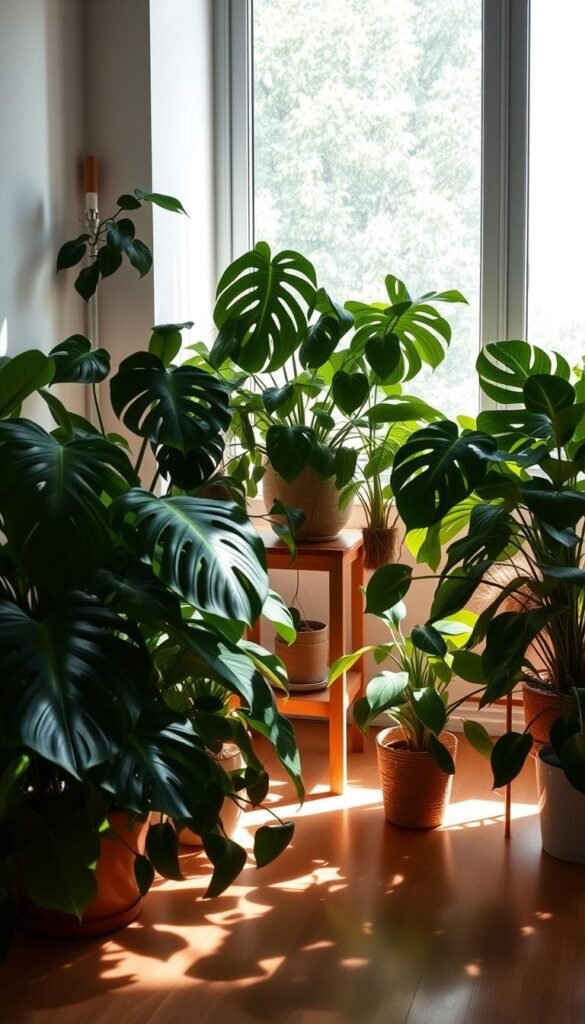
Choosing Appropriate Planters and Containers
The right containers are key for keeping the aesthetic. I choose planters in natural materials that fit well with the design. Neutral-toned ceramic pots and simple wooden containers work well.
It’s important to avoid anything too flashy or bright. This keeps the calm palette intact.
Creating Indoor Garden Corners
These green spots become meditation spots where you can connect with nature. I group plants at different heights using natural wood or stone stands.
The soft sound of leaves and fresh air they provide add to the natural serenity design. This makes Japandi living rooms peaceful and restorative.
8. Optimize Storage Solutions for Clutter-Free Living
I’m totally into how the right storage can make your living room calm and organized. Japandi design is all about clutter-free living that looks easy and natural. Every item should have a purpose and keep the space peaceful.
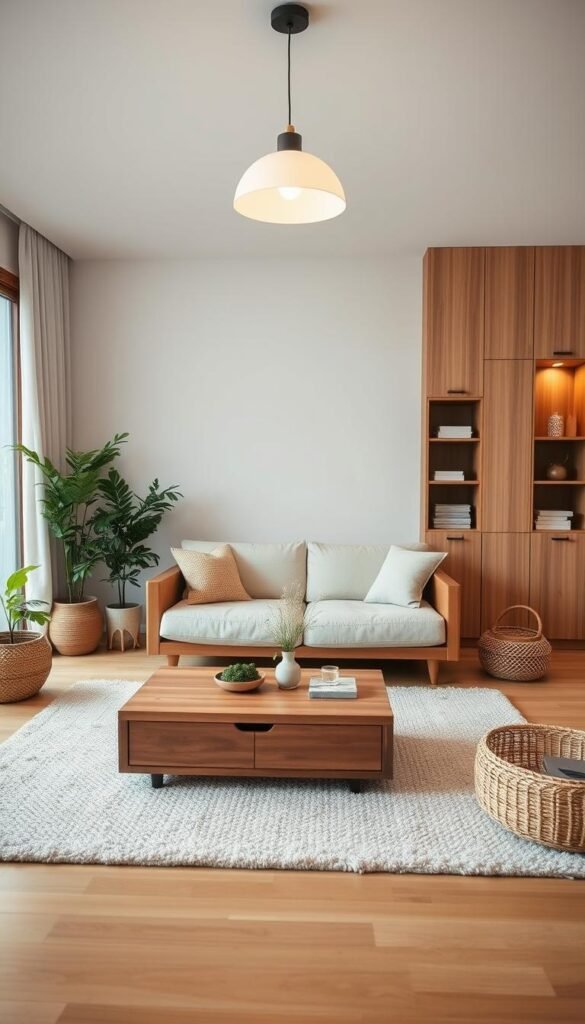
Hidden Storage in Furniture Design
Hidden storage solutions are genius in Japandi spaces! I love ottomans with hidden compartments for blankets and magazines. Coffee tables with drawers keep remotes and books hidden.
Media consoles with sliding doors hide electronics while keeping the look clean. The trick is to pick furniture where storage is part of the design, not an add-on.
Open Shelving with Purposeful Display
Open shelving needs careful planning, but it looks amazing! I arrange shelves with meaningful objects like a vase, books, and a small plant. The trick is to leave space between items.
This isn’t about hiding everything. It’s about showing only what brings joy and is useful in your life.
Traditional Japanese Storage Concepts
Japanese design teaches me my favorite storage tricks! Low cabinets with sliding doors make storage walls. Built-in niches have special spots for items.
I use natural dividers to organize areas in the room. These systems make keeping things tidy easy, so your room always feels calm and clutter-free!
9. Layer Textiles for Comfort and Warmth
Mastering textile layering is key to perfect Japandi living rooms. It adds warmth and comfort without losing the clean look we love. Choose natural fabrics in neutral tones that feel good to touch.
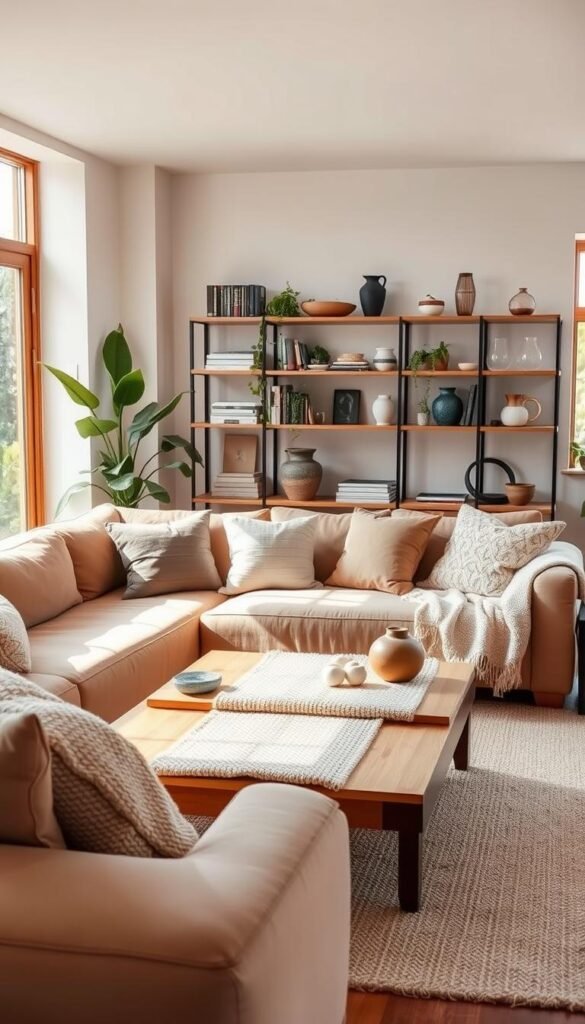
Selecting Throw Pillows and Cushions
I love making the perfect pillow arrangement! I pick pillows in different sizes and textures, not busy patterns. Linen pillows with subtle weaving patterns pair well with cotton cushions in warm beiges.
Mixing textures is magic. I might add a statement pillow in soft sage green. But I always choose natural textures for that luxurious feel. This keeps the look sophisticated and minimalist.
Area Rugs in Natural Fibers
Natural fiber rugs change Japandi spaces! Jute rugs add great texture and define seating areas. Wool rugs in soft grays or creams are comfy and age well.
Choosing the right rug size is important. I pick big sizes to anchor furniture while keeping lines clean. This gives a grounded feel, essential in Japandi design.
Lightweight Throws and Blankets
I use linen throws over sofa arms and fold cotton blankets in baskets. These should be easy to use, not just for show.
The aim is to create layers that invite relaxation. When guests see these thoughtfully placed throws, they feel right at home in your Japandi space.
Creating Your Perfect Japandi Sanctuary
I’m thrilled you’ve discovered the transformative power of japandi living room styling! This design philosophy does more than look good. It sets the stage for mindful living, boosting your daily well-being.
Your calm chic design journey begins with small, thoughtful choices. Start by removing items you don’t need. Then, add something natural, like a wooden coffee table or a linen throw pillow. Each item should bring joy to your daily life.
This aesthetic values quality over quantity. Every piece tells a story of harmony between function and beauty. Neutral colors, natural textures, and clean lines support relaxation and creativity.
Remember, japandi styling grows over time. Trust your instincts as you add plants, adjust lighting, and find the right combinations. The aim is not perfection but a space that supports your tranquility.
Your new sanctuary will remind you to slow down and enjoy life’s simple moments. I’m excited for you to see how this thoughtful design can change your living room and your relationship with home.
To bring you cozy inspiration more efficiently, we sometimes use AI to assist in content creation — but every word and idea is carefully shaped by our team. See our AI Disclosure for more info.

